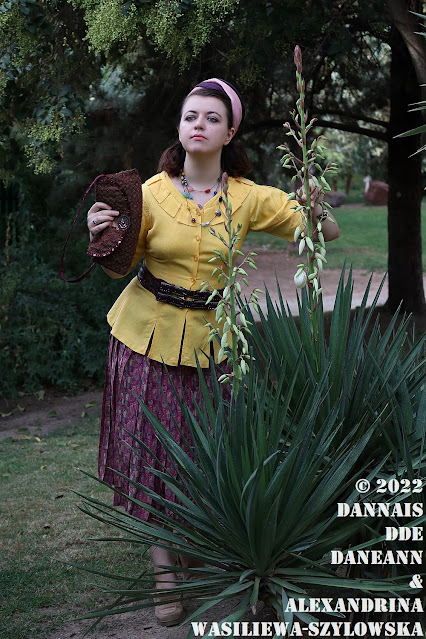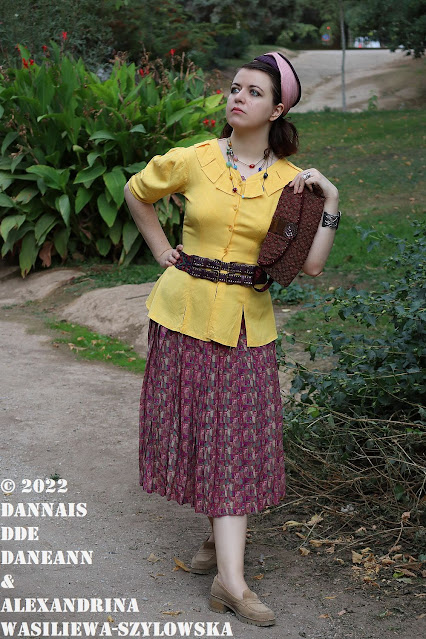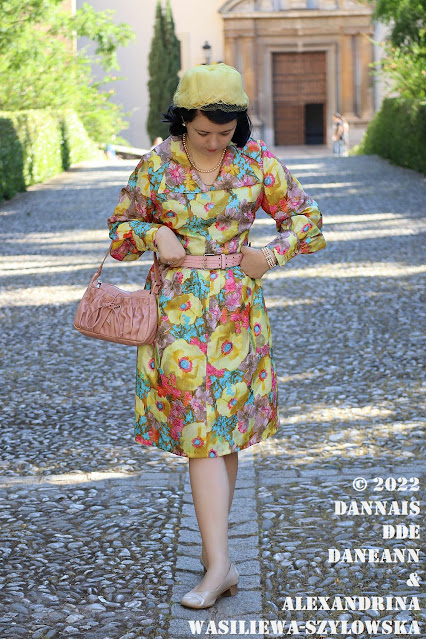Very hot autumn outfit in style of 1938-1939s with real vintage silk turban sculptural hat
Many consider turbans to be only soft cloths wound around the head in a special way. But in my collection, there is a really vintage unusual hat, whose shape is a typical turban. However, the hat is completely dense, with a frame that is covered with several layers of delicate thin silk in two colours. There is even a lining on the inside.
In its style, my hat is somewhat reminiscent of the 1942s hat presented in The Metropolitan Museum of Art.
This piece of vintage hat art belongs to the American designer Sally Victor (1905–1977), who started her hat business back in 1927. This designer loved such extravagant and oriental designs, drawing inspiration from both modern art (like the artist Henri Matisse) and various cultures, both close to her - Native American tribes, and distant such as Japanese samurai armor.
Although she herself described her work rather modestly, as "designing pretty hats that make women look prettier."
Thus, my hat can be dated to the late 1930s - early 1940s, combining the external features of the turban and the internal strength of the hat.
But what is turban and when did it first appear on the stage of world fashion?
The turban (French “turban”,
from Turkish “tulbent”, Persian “dulband” - coarse muslin, headdress) came to
us from Eastern culture, as it is believed as early as the 13th century.
Initially, it was a male headdress - a cloth wrapped around the head, usually
over a fez, scullcap or hat.
As with any other wardrobe
item, the fashion for it either subsided or flared up with renewed vigor. The
size changed, the shape changed, the fabrics changed, the décor changed, but
its turban essence remained unchanged.
So, the turban was popular
during the Renaissance. In addition to the fact that people began to gravitate
towards the antique style, Venetian and Florentine merchants, who traded very
actively with the Ottoman Empire, imported expensive fabrics into Europe:
brocade, silk, etc. Noble people were very fond of decorating themselves with
turbans - no doubt, they added grandeur to them.
European women were already
wearing this exotic wardrobe item in the second half of the 17th century, as
seen in Jan Vermeer's "Girl with a pearl earring" (circa 1665). But
whether the turban then became a super fashion accessory, it is impossible to
say with accuracy. It may have taken another century for this to happen.
In the second half of the 18th century, trade relations between Europe and India increased markedly, and the turban continued to come into fashion. This was facilitated by the Marquise de Pompadour and the Turquerie (anglicized as "Turkery") or "Turquoiserie" style, which dominated in the 18th century.
Many
fashionistas of that time wore not just turbans, but, moreover, decorated them
with feathers and threads of precious stones. This is clearly reflected in the
portraits of the XVIII-XIX centuries. No wonder the famous artist Élisabeth
Vigée Le Brun portrayed herself in this way.
During the Napoleonic wars,
"turban fashion" again actively marched across Europe.
At the era of the Regency
Turkish turbans were also very popular among ladies for evening dress, inspired
by an interest in oriental cultures. It was worn at balls, decorated with
feathers and jewels. The style of the turban was originally simple, matching
the draping of the dresses of the time, but as it grew in popularity as
hairstyles became more elaborate, turbans also became more and more huge and
ornate.

Turbans remained popular
during the "Biedermeier" period, i.e. 1815-1848. But then there was a
slight respite.
A new period of magnificent
flowering of the turban began on the eve of the First World War. A huge role in
its popularization was played by Sergei Diaghilev's "Saisons Russes"
in Paris, namely the ballet "Scheherazade" with costumes created by
the artist Leo Bakst. Parisian fashion houses, and with them the whole world,
were fascinated by the oriental motifs of the "Ballets Russes", and
this could not but affect the appearance of society. From there, bloomers,
kimonos, lampshade skirts, various embroideries on fabrics and turbans went.
Fashion designer Paul Poiret,
who was one of the first to pick up this idea, succeeded especially with the
“oriental” collection. He was very fond of ethnic motifs.
A year after “Scheherazade”, in June 1911, Paul Poiret even arranged a masquerade ball in his Parisian mansion called One Thousand and Two Nights, where everything, down to fountains and fireworks, was stylized as the sultry East.
Those of the three hundred guests who did not comply with the oriental dress code had to either leave the ball or change into costumes from Poiret's new collection. This ball became one of the first fashion shows and at the same time a brilliant advertising campaign for Poiret. Two months later, the fashion designer staged a show where he demonstrated turbans, loose silhouettes and contrasting colours, after which they firmly entered the wardrobe of Parisians.
In 1913, at the premiere of Diaghilev's "The Rite of Spring" ("Le Sacre du printemps"), all the ladies in the Théâtre des Champs-Elysées wore turbans with stones and feathers or tiaras.
Turbans did not lose their popularity during the Art Deco period in the 1920s.
Since the 1930s turbans have been popularized by fashion designer Madame Grès because it was also her favoured headwear.
The popular French fashion magazine Vogue reported in 1940:
“This is the year of the turbans. Why not? They keep the hair intact, they are comfortable to wear in open cars, trains, planes, the turban looks equally elegant with evening wear and trousers."
According to the Kyoto Costume Institute, hairpins disappeared from the market during World War II, so women could not pin up their hair. Big hats, elaborate headdresses, and turbans were a way to get a well-groomed haircut while adding sophistication to the look.
In addition, the turban was a very practical accessory, as it helped to hide the shortcomings of the hairstyle, which consisted not only in the absence of hairpins! During the war years, there was a catastrophic shortage of shampoos and soap, and it was not easy to find a good hairdresser. So the turban helped many women get through this difficult period, making them stylish even at the factory.
Elsa Schiaparelli appeared in the pages of Vogue in 1944 wearing "the first hat of liberated France", which was naturally a turban.
By the end of the Second World War, this accessory has become almost massive. In addition to Schiaparelli, Madame Pauline (sister of American designer Nettie Rosenstein), another of the fashion icons whose military-era headdresses are kept in the Metropolitan Museum of Art, also created turbans.
In 1947, Vogue referred to a whole festival of turbans created by hatters such as the iconic Lilly Daché (who was credited with the idea for the half-hats that became so popular in the 1950s!).
Turbans of the late 1940s were grotesque and very large, just like in the distant first half of the 19th century.
In the post-war years, hats imitating a turban appeared. As a rule, they were soft and without a frame, although they had a mesh base and lining. These turban hats were designed by Christian Dior in the 1950s. Many of his flower hats were nothing more than reimagined turbans.
Legendary actresses from different eras, such as Pola Negri, Gloria Swenson, Greta Garbo, Marlene Dietrich, Vivien Leigh, Grace Kelly, Elizabeth Taylor, Sophia Loren and many others, loved to wear a turban, both in everyday life and going out.
American film costume designer, set designer, and occasional actress Natacha Rambova (née Winifred Kimball Shaughnessy) was a trendsetter of the time, one of the few who had her own individual style and distinctive feature.
She also loved various headdresses, and especially turbans, and was very skillfully able to show them on public. She was considered a style icon, she was admired, imitated. Her hairstyle, clothes, headdresses were always bright and expressive.
She herself said:
“I loathe fashion. I want to dress in a way that is becoming to me, whether it is the style of the hour or not. So it should be with all women, in my opinion.”
By the way, her words perfectly convey my lifestyle.
Like the words of Yves Saint Laurent:
“Fashion fades, style is
eternal”.
I am wearing:
- Real vintage yellow silk button-down fitted peplum blouse with glass buttons, elbow length lantern sleeves, about 1940s
- Real vintage crimson with multi-coloured skyscrapers print pure silk crepe de chine pleated skirt with yoke, made in Italy, about 1970s-1980s
- Real vintage purple and pink pure silk turban sculptural hat, late 1930s-1940s
- Multi toned Murano or Venetian glass and silver toned metal beads on brown cotton 3-strand necklace, made in Italy, about 2000s-2020s
- Real vintage silver toned metal massive cuff bracelet with Celtic weaving, rhinestones and multi-coloured glass cabochon, about 1960s-1970s
- Multi toned leather wide braided belt by “Faith”, made in India, about 1990s
- Burgundy with beige star print, embroidery and sequins, tapestry, satin and leather handbag with metal and rhinestone flower clasp by “Accessorize London”, made in India, about 1990s
- Beige suede mid heel penny-loafers by “Aback”, made in Spain, 2020s
I think that I ended up with
an outfit in the style of the late 1930s, specifically 1938-1939s. Recently, I
try to experiment more and more often with bright colours. Bright colours have
always been in fashion, and especially in the period I reproduce.



















































Comments
Post a Comment